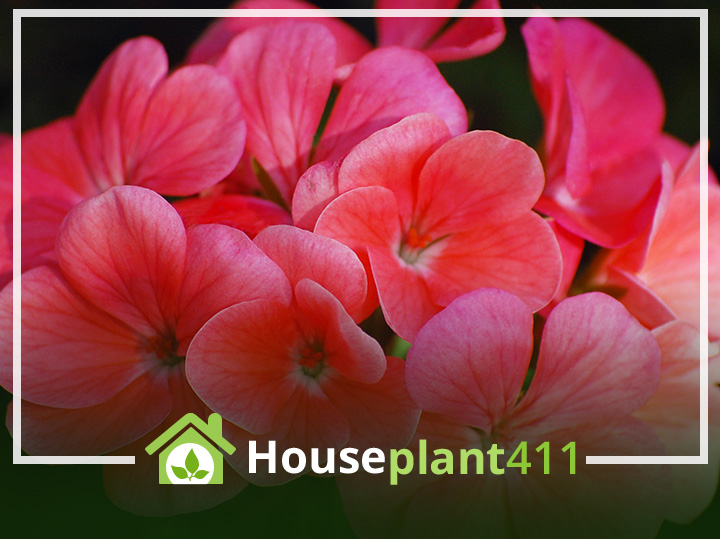A geranium plant is a very popular outdoor plant, but also makes a great indoor flowering plant. Geraniums are part of the genus Pelargonium which means “stork” in Latin. Native wildflowers and herbaceous perennials are the real members of the Geranium genus. There are over 200 Pelargonium species, most of them originating in South Africa. A Geranium plant produces clusters of flowers that come in a variety of colors such as white, pink, salmon, red, fuchsia, and lavender. Leaves are green, green and white, or multicolored. Geranium plants can be a compact upright plant or a graceful hanging vine. The vibrantly colored geranium flowers do not have an appealing aroma, but there are several geranium varieties that produce leaves with lovely scents such as rose, lime, peppermint, lemon, orange, or lime. These plants are considered slightly poisonous and should be kept away from pets and children. Read more about common houseplants that are poisonous in Don’t Feed Me To Your Cat! A Guide to Poisonous Houseplants. Geranium plants are a great addition to your houseplant plant collection, but very need very bright light or direct sun for at least 6-8 hours a day to bloom indoors.
Plant Care
Light
Geranium plants grow indoors when placed in moderate light, but only bloom in very bright intense light. Fluorescent lights about 10 to 12 inches from a geranium plant can be used to supplement natural light
Water
Geranium plants survive being under- watered but quickly develop root- rot when over- watered. Wait until the top 50% of the soil is dry, before watering.
Fertilizer
Feed monthly in the spring and summer with a water-soluble houseplant fertilizer. Geranium plants need food only when they are actively growing.
Temperature
Geranium plants prefer cool temperatures between 65°-70° F (18.3° 21.1°C) during the day, and around 55°F (12.8°C) at night. Avoid placing a geranium plant in cold, drafty areas or hot, dry places.
Humidity
Geranium plants grow well in normal household humidity. Very high humidity encourages bacterial and fungal infections; very low humidity encourages spider mites.
Flowering
Geranium Plants need very bright intense light to bloom indoors. Immediately remove dead or faded flowers to encourage a Geranium to produce more flowers.
Pests
Aphids, whitefly, and spider mites can be a plant pest problem. If you put your Geranium outside for the summer, be careful caterpillars don’t munch on it.
Diseases
Bacterial leaf spot, gray mold, blossom blight, or rust are plant diseases that attack geranium plants if the humidity is too high or if the soil or leaves stay wet.
Soil
Use a quick- draining, all- purpose, loose houseplant potting mixture that contains a fair amount of nutrients. If your geranium soil is heavy and clay-like, add some sand and compost to it.
Pot Size
As with all container plants, geraniums should be planted in pots with drainage holes. These plants like to be root-bound so don’t rush to re-pot them. When you move geraniums to a larger pot, use a container only one size larger than your existing pot.
Pruning
Pruning a geranium plant helps keep it looking full. Cut back woody and leggy stems to keep the plant compact and bushy.
Propagation
Geranium plants are easily propagated using stem cuttings in the spring.
Poisonous Plant Info
Geranium plants are slightly poisonous with a level #1 toxicity.
FAQ
There is a new plant called a Mosquito Geranium that has genes coded for citronella, which repels mosquitoes. The citronella smell of this geranium plant is released when the leaves are rubbed or crushed. Research is still being conducted to prove whether this particular geranium plant is really a mosquito repellant.
Spots on the leaves, dropping leaves, and soggy stems sounds like Bacterial Leaf Spot Disease. It is caused by warm humid air and poor air circulation around plants. Treat Bacterial Leaf Spot Disease by immediately removing any geranium plant leaves that have signs of the disease, keep the plant leaves and stems dry at all times, and place the geranium near a small fan to increase air circulation. If the Bacterial Leaf Spot Disease persists, try a copper Fungicide.
Geranium plants do not bloom indoors if they are not getting very bright light 6-8 hours a day. Move your plant to brighter light and see what happens.
Botrtis, a fungus infection caused by water getting on the geranium flowers, causes the center of the flowers to dry out. Botritis comes from poor air circulation, getting the flowers wet, or just over-watering a geranium.

